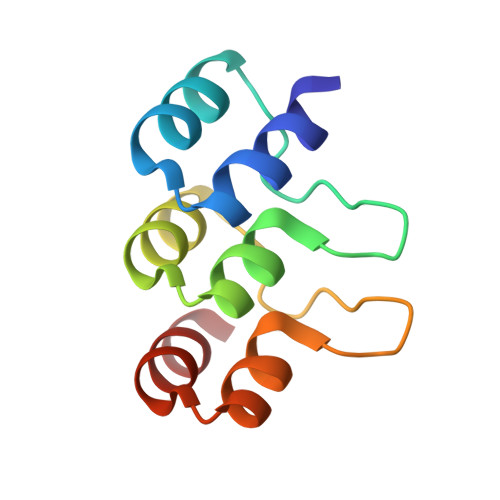Structural Determinants for Improved Thermal Stability of Designed Ankyrin Repeat Proteins with a Redesigned C-Capping Module.
Kramer, M., Wetzel, S.K., Pluckthun, A., Mittl, P., Grutter, M.(2010) J Mol Biol 404: 381
- PubMed: 20851127
- DOI: https://doi.org/10.1016/j.jmb.2010.09.023
- Primary Citation of Related Structures:
2XEE, 2XEH, 2XEN - PubMed Abstract:
Designed ankyrin repeat proteins (DARPins) that specifically bind to almost any target can be obtained by ribosome display or phage display from combinatorial libraries. Although DARPins are already very stable molecules, molecular dynamics simulations, equilibrium denaturation experiments, structural studies, and recent NMR experiments suggested that the unfolding of the original C-terminal capping repeat (C-cap), taken from a natural ankyrin repeat protein, limits the stability of the initial DARPin design. Several point mutations had been introduced to optimize the C-cap and were shown to indeed further increase the stability of DARPins. We now determined crystal structures of DARPins with one or three full-consensus internal repeats (NI(1)C or NI(3)C) between an N-terminal capping repeat and mutants of the C-cap. An NI(1)C mutant, in which the C-cap was only extended by three additional helix-forming residues, showed no structural change but reduced B-factors in the C-cap. An NI(3)C C-cap mutant carrying five additional mutations in the interface to the preceding repeat, previously designed by using the consensus sequence as a guide, showed a rigid-body movement of the C-cap towards the internal repeat. This movement results in an increased buried surface area and a superior surface complementarity and explains the improved stability in equilibrium unfolding, compared to the original C-cap. A C-cap mutant with three additional mutations introducing suitably spaced charged residues did not show formation of salt bridges, explaining why its stability was not increased further. These structural studies underline the importance of repeat coupling for stability and help in the further design of this protein family.
Organizational Affiliation:
Department of Biochemistry, University of Zürich, Winterthurerstr. 190, 8057 Zürich, Switzerland.

















